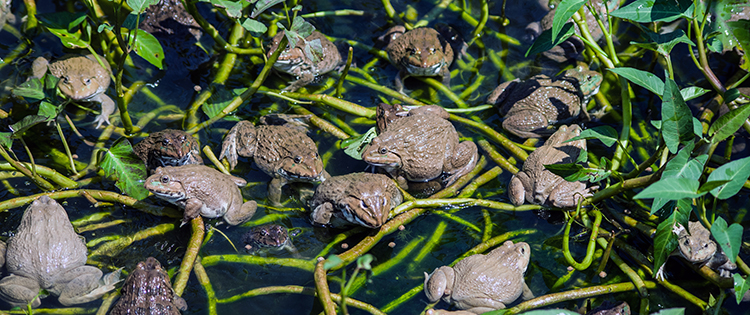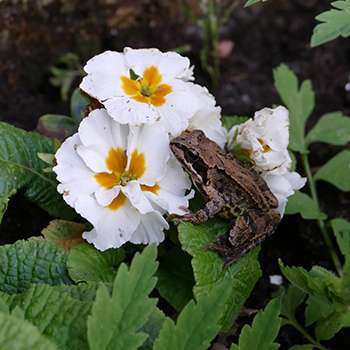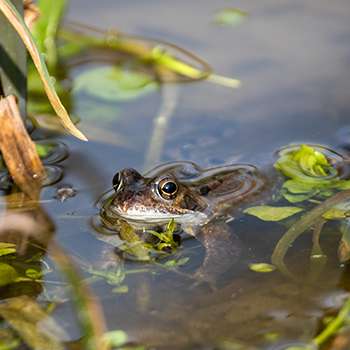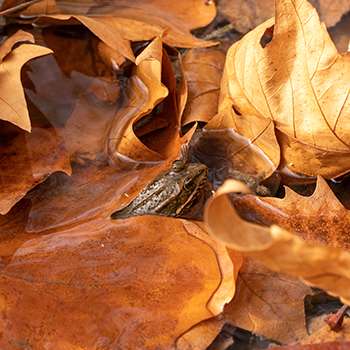You will hear children squeal in terror when they catch a glimpse of a slimy-looking amphibian hopping across the grass. But for the gardener, they are an absolute delight! Frogs and toads will keep your garden free from pests, and they are a sign that your backyard ecosystem is thriving, making it a good idea to create some room for them in your garden. Keep reading to find out why you need to attract frogs and toads, and how.
The Benefits of Having Frogs and Toads in Your Garden
One frog will consume over 10,000 bugs in one season! Once you have enough frogs in your garden, they’ll eliminate all the plant and vegetable eating pests that might otherwise grow out of control and overpopulate your garden.
Frogs and toads don’t do well in unhealthy environments, which makes them effective bio-indicators. In other words, if you do manage to attract some amphibians, and they disappear, you’ll know there’s something unhealthy in your environment that’s driving them out.
Finally, making your garden a safe haven for frogs will prevent them from going extinct. The National Wildlife Federation has reported that some frog species are in decline, and because of the chemicals in the environment, many are being inflicted with deformities.
Stop Using Chemicals in Your Garden
The first thing you will need to do if you want to attract toads and frogs is to stop using chemicals. Amphibians breathe and hydrate through their skin, which means they absorb everything in their environment. Common garden fertilizers such as synthetic fertilizers, herbicides, and pesticides could poison frogs and toads, which defeats the purpose of attracting them in the first place. Start treating your garden organically by doing the following:
- Replace your use of synthetic fertilizer by using nutrient-rich soils that work well with your plants.
- Rotate your crops to maintain richness in the soil.
- If you are going to use fertilizer, make sure it’s organic.
Avoid Toxic Plants
There are some vegetables and flowers that will poison your frogs. Vegetables that can cause frogs harm include potatoes, snow peas, rhubarb, and eggplant. Flowers that are harmful to frogs include hyacinth, daffodils, hydrangeas, azaleas, and honeysuckle.
Give Frogs and Toads Access to Shallow Water
Frogs and toads breathe and drink through their skin, for them to perform these functions, they need moist skin. Therefore, the most important step in attracting frogs and toads to your garden is giving them access to shallow fresh water in a shaded area.
- If you’ve got a pond or another type of built-in water source in your garden, great! If not, fill some shallow dishes with water and place them in a shady area. Wash the dishes and change the water once a week.
- Create a makeshift pond by digging a small hole in the ground, and placing a plastic tub filled with water into it.
- Your water sources will need to be large enough to house young and adult frogs because they spawn in water.
Provide Frogs and Toads With Food
Frogs eat insects, and they will go where the food is. The best way to attract insects to your garden is to plant a variety of seasonal flowering plants throughout the year. In this way, plenty of nectar-eating bugs will make their way to your garden.
Keep a Mulch Bed and a Compost Heap
Frogs and toads like eating the bugs that are attracted to mulch beds and compost heaps. Also, they like living in damp conditions, and the mulch and compost will provide this.
Keep Your Trees Leafy
Don’t trim tree branches or back bushes near food sources or water, this will provide tree frogs with a natural habitat. Keeping your shrubs and trees leafy and full will provide frogs with a good hunting ground, and give them plenty of covers.
You should also keep a light on during the night because tree frogs eat moths and insects that are attracted to light. By keeping a garden light on for all, or part of the night, you will create a feeding spot that moths and insects won’t be able to resist.
Give Frogs and Toads a Damp Shaded Shelter
Frogs and toads don’t like the sun because too much exposure can cause them to become dehydrated. For this reason, they are most active at night; you can help them out by creating a cave-like shelter for them to rest in during the day. Position it out of direct sunlight, and make sure predators don’t have access to it.
You can create a shelter by using an overturned ceramic pot. Prop it up against some rocks in a shady location with easy access to a water source. Leave enough room between the earth and the rim of the pot so the frogs can come and go.
Give Frogs and Toads Cover
Where ever your pond or water source is, keep at least one edge of it covered with leafy plants. Plant leafy perennials and grasses around the edges of water sources to provide frogs and toads with enough shade, protection, and dampness.
If you want to attract local species, you will need to plant native plants around your water source. Choose a selection of clumping plants like lilies and ferns, native grasses, and ground covers like vines and shrubs.
Keep the Grass Low
Increase your frog’s lifespan by keeping your grass low. Frogs like hiding in tall grass, and it’s not uncommon for them to fall victim to a lawnmower blade. By keeping your grass short, it will be easier for you to see when there are any rogue amphibians in your path.
Final Thought
After you’ve done all the hard work and created the right environment, don’t expect toads and frogs to turn up in your garden overnight, it could take up to two years to populate your yard. You can speed up the process by placing tadpoles in your pond during the spring months. However, for this to work, the tadpole will need to be native to your area.
You may also like:
The Succulent Red Plant That Tastes Like Bacon (Video)
How To Make Bio Fuel From Kitchen Scraps
8 Best Natural Ways To Stop Slugs And Snails From Destroying Your Plants
Ingenious Ways To Use Toilet Paper Rolls That You Never Thought Of












